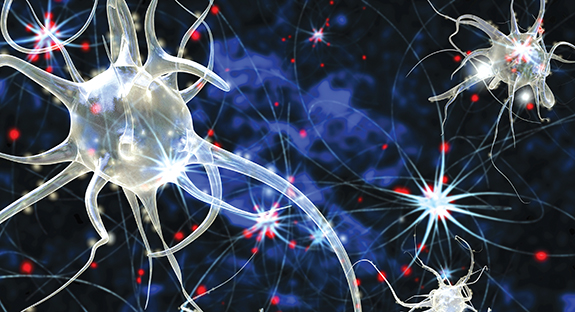Flexing the Brain: Engineers Discover Why Learning Can Be Difficult
Learning a new skill is easier when it is related to ability that we already possess. For example, a trained pianist might learn a new melody more easily than learning how to hit a tennis serve.
a new skill is easier when it is related to ability that we already possess. For example, a trained pianist might learn a new melody more easily than learning how to hit a tennis serve.
Neural engineers from the Center for the Neural Basis of Cognition—a joint program between the University of Pittsburgh and Carnegie Mellon University—have discovered a fundamental constraint in the brain that may explain why this happens. Published as the cover story in the Aug. 28, 2014, issue of Nature, they found for the first time that there are constraints on the brain’s adaptability during learning and that these constraints are the key determinant for whether a new skill will be easy or difficult to learn. Understanding the ways in which the brain’s activity can be “flexed” during learning could eventually be used to develop better treatments for stroke and other brain injuries.
Lead author Patrick T. Sadtler, a PhD candidate in Pitt’s Department of Bioengineering, compared the study’s findings to cooking.
author Patrick T. Sadtler, a PhD candidate in Pitt’s Department of Bioengineering, compared the study’s findings to cooking.
“Suppose you have flour, sugar, baking soda, eggs, salt, and milk. You can combine them to make different items—bread, pancakes, and cookies—but it would be difficult to make hamburger patties with the existing ingredients,” Sadtler said. “We found that the brain works in a similar way during learning and that subjects were able to more readily recombine familiar activity patterns in new ways relative to creating entirely novel patterns.”
For the study, the research team trained animals to use a brain-computer interface—technology that allows a person to control a computer or machinery with his or her thoughts—similar to ones that have shown recent promise in clinical trials for assisting tetraplegics and amputees.
“This evolving technology is a powerful tool for brain research,” said Daofen Chen, program director at the National Institute of Neurological Disorders and Stroke, part of the National Institutes of Health, which supported this research. “It helps scientists study the dynamics of brain circuits that may explain the neural basis of learning.”
evolving technology is a powerful tool for brain research,” said Daofen Chen, program director at the National Institute of Neurological Disorders and Stroke, part of the National Institutes of Health, which supported this research. “It helps scientists study the dynamics of brain circuits that may explain the neural basis of learning.”
The researchers recorded neural activity in the motor cortex and directed the recordings into a computer, which translated the activity into movement of a cursor on the computer screen. This technique allowed the team to specify the activity patterns that would move the cursor. The subjects’ goal was to move the cursor to targets on the screen, which required them to generate the patterns of neural activity that the experimenters had requested. If the subjects could move the cursor well, that meant that they had learned to generate the neural activity pattern that the researchers had specified.
The researchers found that their subjects learned to generate some neural activity patterns more easily than others, since they only sometimes achieved accurate cursor movements. The harder-to-learn patterns were different from any of the pre-existing patterns, whereas the easier-to-learn patterns were combinations of pre-existing brain patterns. Because the existing brain patterns likely reflect how the neurons are interconnected, the results suggest that the connectivity among neurons shapes learning.
researchers found that their subjects learned to generate some neural activity patterns more easily than others, since they only sometimes achieved accurate cursor movements. The harder-to-learn patterns were different from any of the pre-existing patterns, whereas the easier-to-learn patterns were combinations of pre-existing brain patterns. Because the existing brain patterns likely reflect how the neurons are interconnected, the results suggest that the connectivity among neurons shapes learning.
“We wanted to study how the brain changes its activity when you learn and also how its activity cannot change. Cognitive flexibility has a limit—and we wanted to find out what that limit looks like in terms of neurons,” said Aaron P. Batista, assistant professor of bioengineering at Pitt and coprincipal investigator on the study with Byron M. Yu, assistant professor of electrical and computer engineering and biomedical engineering at Carnegie Mellon. Yu believes this work demonstrates the utility of brain computer interfaces for basic scientific studies that will eventually have an impact on people’s lives.
“These findings could be the basis for novel rehabilitation procedures for the many neural disorders that are characterized by improper neural activity,” Yu said. “Restoring function might require a person to generate a new pattern of neural activity. We could use techniques similar to what were used in this study to coach patients to generate proper neural activity.”
The Center for the Neural Basis of Cognition is devoted to investigating the neural mechanisms that give rise to human cognitive abilities. The center integrates the strengths of the University of Pittsburgh in basic and clinical neuroscience with Carnegie Mellon’s strengths in computer science and other selected disciplines and also sponsors an interdisciplinary graduate training program. The Center for the Neural Basis of Cognition will celebrate its 20th anniversary of advancing brain, computation, and behavior through research and education this fall. Visit http://www.cnbc.cmu.edu/ for more information.
The research was funded by the National Institutes of Health, the National Science Foundation, and the Burroughs Wellcome Fund.
Other Stories From This Issue
On the Freedom Road

Follow a group of Pitt students on the Returning to the Roots of Civil Rights bus tour, a nine-day, 2,300-mile journey crisscrossing five states.
Day 1: The Awakening
Day 2: Deep Impressions
Day 3: Music, Montgomery, and More
Day 4: Looking Back, Looking Forward
Day 5: Learning to Remember
Day 6: The Mountaintop
Day 7: Slavery and Beyond
Day 8: Lessons to Bring Home
Day 9: Final Lessons

